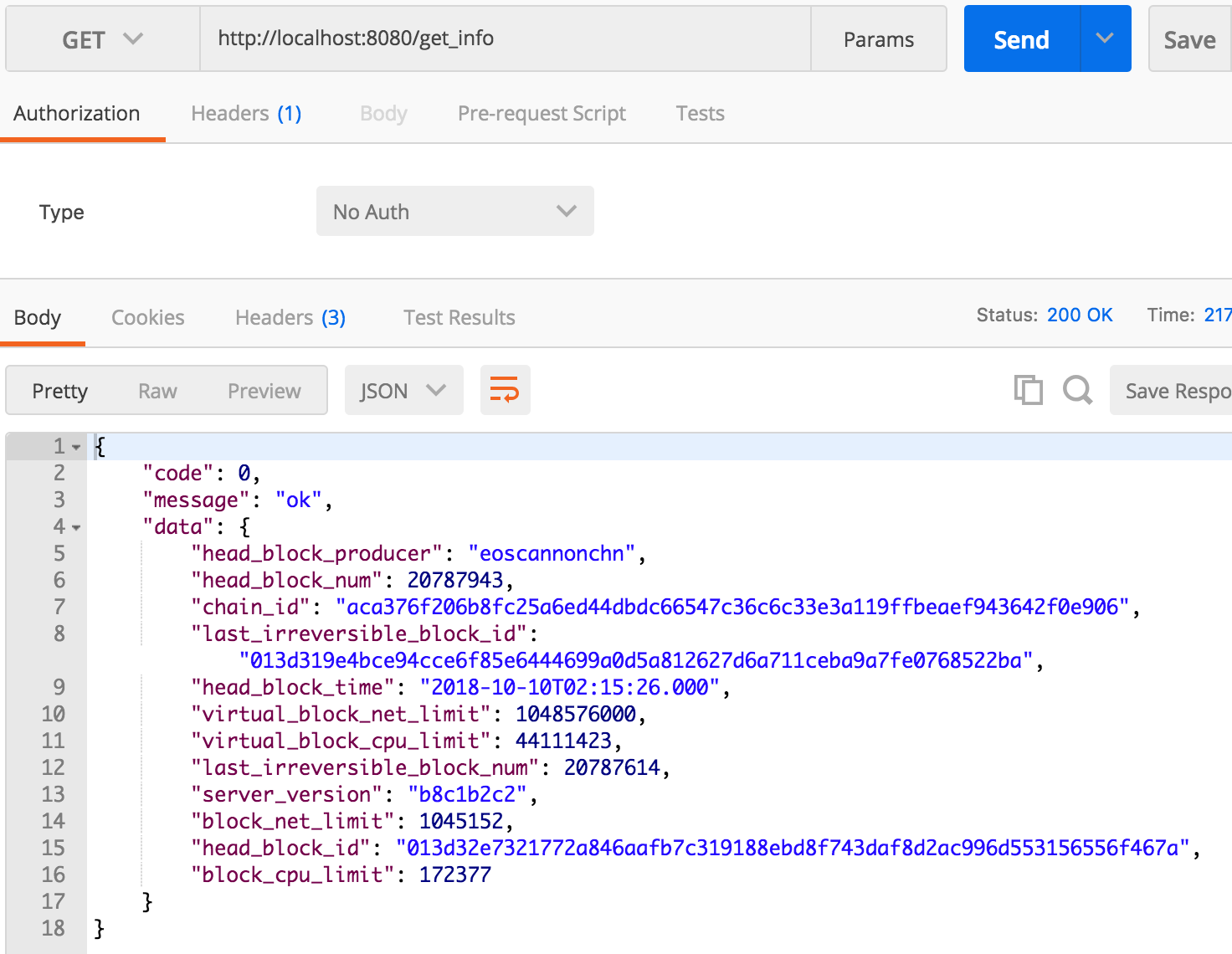EosProxyServer is the FULL-FUNCTIONAL backend server of PocketEOS, which is developed by OracleChain.io.
This project is the full-funcional backend server for PocketEos-Android/PocketEos-IOS.
What does this project provide:
1.Realtime market rates: Our token rates are sourced from coinmarketcap and newdex.
2.We provide a general EOS error code SPEC without importing EOSIO code base(EOSJS/EOS C++): The standard error code could make better user experience, and make users have a better understanding of what really happened when something's wrong.
3.Use our JAVA server to create new accounts.We provide two ways to make free new account.
4.Use our JAVA server to sign server side transactions, such as: transferring for airdrops, or calling a complex contract.
Compile EosProxyServer from source code:
prepare a redis server for data cache of token rates
install IntelliJ IDEA + jdk1.8 + maven 4.0.0
clone our git repository.
git clone https://github.com/OracleChain/EosProxyServer.git
import the project with IntelliJ IDEA
edit redis server configuration in src/main/resources/application.yml.
host: redis_server_ip
port: redis_server_port
password: redis_passwd
public static final String eosAccount = "tx_account_name";
public static final String eosPrivateKey = "tx_private_key";
public static final String eosAccountVip = "tx_account_name";
public static final String eosPrivateKeyVip = "tx_private_key";
We use eosAccount/eosPrivateKey to create free account(fixed Ram/Bandwidth) or push action, as long as the account have tokens to do it.
Meanwhile, the eosAccountVip/eosPrivateKeyVip would have sufficent EOS to create vip accounts(with flexible Ram/Bandwidth), but it have to be verified in RPC call with an invite code or server ticket(key-value in redis in this case).
Run it.
Make a request on Browser/Postman for testing

We provide client a more stable environment, smooth version upgrading, universal error exceptions with resolving all EOS exceptions into one standard.
With the univeral error exceptions, you can make more internationalized error tips for users.
In EOS code base, the exceptions were handled in three layers.
1.the FC layer, handling the graphene tool exceptions.
2.the CHAIN layer, handling EOS chain logic exceptions.
3.In the CONTRACT layer, you can standardize a general error code specification in your contract code. Then you can catch the contract error code with a parser in CODE.
4.What's more, there is internationalization project keeping track of the error code specification in EOS code EOSIO API ERROR CODE SPECIFICATION.If you are interested in this project, you can join us on telegram.
EOS is based on grephene framework, which defines the error code of FC layer in FC expceptions file.
We unified the error code with a offset of 3990000.

When dealing with EOS blockchain rpc service, most of the exceptions were CHAIN exceptions, and we using it directly with some self defined code here.

Let's take OracleChainToken contract for example, the contract address is "octtothemoon", with our symbol "OCT"
1.modify dto/AccountAssetInfo.java entity, which defines the response of assets query:
private String oct_balance;
private String oct_balance_usd;
private String oct_balance_cny;
private String oct_price_usd;
private String oct_price_cny;
private String oct_price_change_in_24h;
private String oct_market_cap_usd;
private String oct_market_cap_cny;2.modify controller/QueryTabController.java, the get_account_asset interface, to make adaptions to new tokens:
//get token balance for the user "octgenerator"
BigDecimal oct_balance = blockServiceEos.getBalance(
Variables.eosChainUrl,
"octtothemoon",
"OCT",
"octgenerator");
//resolve third party token rates with fiat currency, and we store the rate in redis(the way of cache is pretty simple, which should be improved in production env.)
redis_key = Variables.redisKeyPrefixBlockchain+ Variables.redisKeyEosCoinmarketcapMid+ "oraclechain";
CoinMarketTicker coinMarketTicker_oct = redisService.get(redis_key, CoinMarketTicker.class);
if(coinMarketTicker_oct == null){
try{
req_url.append(Variables.COINMARKETCAP_TICKER).append("oraclechain").append("?convert=CNY");
result = HttpClientUtils.get(req_url.toString(), "UTF-8");
coinMarketTicker_oct = JSON.parseArray(result, CoinMarketTicker.class).get(0);
redisService.set(redis_key, coinMarketTicker_oct, Variables.redisCacheTimeout);
}
catch (Exception e)
{
throw new ExceptionsChain(ErrorCodeEnumChain.unknown_market_id_exception);
}
}
//finally we send the token info with AccountAssetInfo entity
AccountAssetInfo asset_info= new AccountAssetInfo();
BigDecimal oct_usd_price = new BigDecimal(coinMarketTicker.getPrice_usd());
BigDecimal oct_cny_price = new BigDecimal(coinMarketTicker.getPrice_cny());
double oct_price_change_in_24h = Double.valueOf(coinMarketTicker.getPercent_change_24h());//.doubleValue();
asset_info.setOct_balance(oct_balance.setScale(Variables.precision, RoundingMode.DOWN).toPlainString());
asset_info.setOct_balance_usd(oct_balance.multiply(oct_usd_price).setScale(Variables.precision, RoundingMode.DOWN).toPlainString());
asset_info.setOct_balance_cny(oct_balance.multiply(oct_cny_price).setScale(Variables.precision, RoundingMode.DOWN).toPlainString());
asset_info.setOct_price_usd(oct_usd_price.toString());
asset_info.setOct_price_cny(oct_cny_price.toString());
asset_info.setOct_price_change_in_24h(Double.toString(oct_price_change_in_24h));
asset_info.setOct_market_cap_usd(coinMarketTicker.getMarket_cap_usd());
asset_info.setOct_market_cap_cny(coinMarketTicker.getMarket_cap_cny());You can provide a server side transaction by define a peer of operation account and private key in src/main/java/com/oraclechain/eosio/constants/Variables.java.
Then, using push_action/create_account/create_vip_account RPC interface(in TransactionController) to handle the trx request.
As the world’s first application built on an EOS ecosphere, OracleChain needs to meet the demands of the Oracle (oracle machine) ecosystem by efficiently linking blockchain technology services with various real-life scenarios, thereby delving into this immense tens of billions of dollars valuation market.
As a decentralized Oracle technology platform based on the EOS platform, the autonomous Proof-of-Reputation & Deposit mechanism is adopted and used as a fundamental service for other blockchain applications.In addition to Oracle services that provide real-world data to the blockchain, Oracle services that provide cross-chain data are also offered. Given that OracleChain can accomplish the functions of several prediction market applications, such as Augur and Gnosis, OracleChain can also support smart contract businesses that require high-frequency access to outside data in certain scenarios, such as Robo-Advisor.
OracleChain will nurture and serve those blockchain applications that change the real world. Our mission is to “Link Data, Link World,” with the aim of becoming the infrastructure linking the real world with the blockchain world.
By achieving intra-chain and extra-chain data connectivity, we aspire to create a service provisioning platform that can most efficiently gain access to extra-chain data in the future blockchain world.
Released under GNU/LGPL Version 3
ECDSA and chain utility are based on the source code of EOSCommander,thx for the contribution of PLAYERONE.ID team!
If you found this project useful, vote us(oraclegogogo) and have fun with EOS.